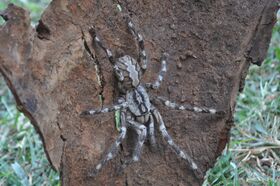Biology:Poecilotheria rajaei
| Poecilotheria rajaei | |
|---|---|

| |
| Poecilotheria rajaei | |
| Scientific classification | |
| Domain: | Eukaryota |
| Kingdom: | Animalia |
| Phylum: | Arthropoda |
| Subphylum: | Chelicerata |
| Class: | Arachnida |
| Order: | Araneae |
| Infraorder: | Mygalomorphae |
| Family: | Theraphosidae |
| Genus: | Poecilotheria |
| Species: | P. rajaei
|
| Binomial name | |
| Poecilotheria rajaei | |
| Synonyms[4][5] | |
|
Poecilotheria amarasekarai | |
Poecilotheria rajaei is a tarantula in the genus Poecilotheria endemic to Sri Lanka.[6][7]
Genus
The genus is native to Sri Lanka and India . The name Poecilotheria is derived from Greek: "poikilos", meaning spotted, and "therion", meaning wild beast.[6]
Discovery
P. rajaei was officially described in a 2012 publication of the British Tarantula Society.[3] It was discovered in 2009 when a villager brought a dead specimen to Ranil Nanayakkara, the co-founder of the Sri Lankan Biodiversity Education and Research organization, who was conducting an arachnid survey of Sri Lanka at the time.[6]
Description
The spider has a leg span of up to 20 centimetres (8 in), has vivid yellow and gray piping on the first and fourth legs with a pink abdominal band. It prefers to live in old-growth trees, but is considered rare due to deforestation in its war-torn habitat and has taken to living in old buildings. The venom of P. rajaei is not lethal to humans but can kill small rodents, birds, lizards and snakes. It is not yet known exactly how rare the newly discovered tarantula is, but there is some concern that habitat destruction is causing their number to dwindle.
The species was named for Michael Rajakumar Purajah, the local police inspector who guided the research team while they searched for living specimens.[6]
References
- ↑ "Appendices | CITES". https://cites.org/eng/app/appendices.php.
- ↑ "Taxon details Poecilotheria rajaei Nanayakkara et al., 2012". World Spider Catalog. Natural History Museum Bern. http://www.wsc.nmbe.ch/species/37827. Retrieved 29 February 2016.
- ↑ 3.0 3.1 Nanayakkara, RP; Kirk, PJ; Dayananda, SK; Ganehiarachchi, GASM; Vishvanath, N; Kusuminda, TGT (2012). "A new species of tiger spider, genus Poecilotheria, from northern Sri Lanka". British Tarantula Society Journal 28 (1): 6–15.
- ↑ "Spiders of Sri Lanka - Palinda Perera". http://www.environmentlanka.com/yba/spiders.php.
- ↑ "Vol. 17 (2012): Proceedings of 17th International Forestry and Environment Symposium 2012 | Proceedings of International Forestry and Environment Symposium". http://journals.sjp.ac.lk/index.php/fesympo/issue/view/37/showToc.
- ↑ 6.0 6.1 6.2 6.3 Drake, Nadia. "New Giant Tarantula Discovered in Sri Lanka". Wired (Wired.com). https://www.wired.com/wiredscience/2013/04/new-giant-tarantula/?cid=co6823174. Retrieved 2013-04-04.
- ↑ "Spiders as big as your face discovered in Sri Lanka". Metro.co.uk. 3 April 2013. http://metro.co.uk/2013/04/03/spiders-as-big-as-your-face-discovered-in-sri-lanka-3581017/. Retrieved 2013-04-04.
Wikidata ☰ Q10294423 entry
 |

